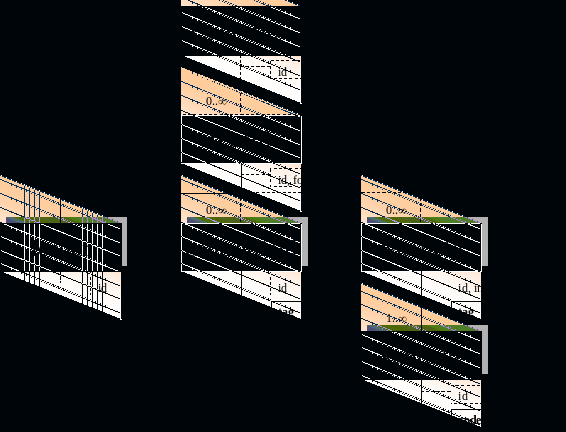chapter 01 - limits, alternatives, and choices (appendix) chapter 01 limits, alternatives, and choices (appendix) appendix questions
Chapter 01 - Limits, Alternatives, and Choices (Appendix)
Chapter 01 Limits, Alternatives, and Choices (Appendix)
Appendix Questions
1. Briefly explain the use of graphs as a way to represent economic
relationships. What is an inverse relationship? How does it graph?
What is a direct relationship? How does it graph? LO7
Answer: Graphs help us visualize relationships between key economic
variables in the data. For example, the relationship between the price
of oranges and the number of oranges purchased is likely to be an
inverse relationship. An inverse relationship is one where we observe
one variable increasing and the other variable decreasing as a result
(moving in opposite directions). Thus, as the prices of oranges
increase we would expect to see a decrease in the quantity of oranges
purchased. Graphically, we represent this inverse relationship as
follows.
As another example, the relationship between the quality of a textbook
and the number of textbooks sold is likely to be a direct
relationship. A direct relationship is one where we observe one
variable increasing and the other variable increasing as a result
(moving in the same direction). Thus, as the quality of the textbook
increases the number of books sold also increases. Graphically, we
represent this direct relationship as follows.
2. Describe the graphical relationship between ticket prices and the
number of people choosing to visit amusement parks. Is that
relationship consistent with the fact that, historically, park
attendance and ticket prices have both risen? Explain. LO7
Answer: There is likely an inverse relationship between ticket prices
and the number of people visiting amusement parks. As ticket prices
increase relative to other goods, people will spend their income on
these other goods. For example, they may decide to go to the movies
instead of visiting the now more expensive amusement park.
The fact that, historically, park attendance and ticket prices have
both risen over time does not change our story. This relationship is
most likely the result of a change in demand, not a change in quantity
demanded. The demand schedule for amusement parks has probably shifted
to the right (an increase in demand) over time leading to an increase
in attendance and prices.
3. Look back at Figure 2, which shows the inverse relationship between
ticket prices and game attendance at Gigantic State University. (a)
Interpret the meaning of both the slope and the intercept. (b) If the
slope of the line were steeper, what would that say about the amount
by which ticket sales respond to increases in ticket prices? (c) If
the slope of the line stayed the same but the intercept increased,
what can you say about the amount by which ticket sales respond to
increases in ticket prices? LO7
Answer:
Part a: The slope of this relationship tells us how much the price of
a ticket must fall to induce someone to buy an additional ticket. In
this case, the slope of -2.5 tells us that the price must fall by
$2.50 to sell one more ticket (or to induce someone to buy one more
ticket). The vertical intercept tells us the price at which no tickets
will be sold. Here, this price is $50. Combining these two components
tells us that if the initial price is $50 per ticket and the price
falls to $40, then 4 tickets will be purchased (one for each reduction
in price of $2.50, which is the slope).
Part b: If the slope of this line were steeper this would imply that
the price must fall by more than $2.50 to sell one more ticket. Or,
thinking about this in the other direction, a steeper line would
result in a smaller decrease in tickets purchased for a given increase
in price. In other words, ticket sales (purchases) are less responsive
to price movements.
Part c: If the vertical intercept increased this would imply that
individuals are willing to purchase more tickets at every price. This
will be an increase in the demand for tickets. This will not affect
the slope or the quantity response to a change in the price of
tickets. We still have the relationship that the price must fall by
$2.50 to sell one more ticket (or to induce someone to buy one more
ticket).
Appendix Problems
1. Graph and label as either direct or indirect the relationships you
would expect to find between (a) the number of inches of rainfall per
month and the sale of umbrellas, (b) the amount of tuition and the
level of enrollment at a university, and (c) the popularity of an
entertainer and the price of her concert tickets. LO7
Answer:
Part a:
Part b:
Part c:
Feedback: Consider the following situations:
Part a: The number of inches of rainfall per month and the sale of
umbrellas: There is likely a direct relationship between the number of
inches of rainfall per month and the sale of umbrellas (more rain
implies more umbrellas).
Part b: The amount of tuition and the level of enrollment at a
university: There is likely an inverse relationship between the amount
of tuition and the level of enrollment at a university. As tuition
increases less students will attend the university.
Part c: The popularity of an entertainer and the price of her concert
tickets: There is likely a direct relationship between the popularity
of an entertainer and the price of her concert tickets. The more
popular the entertainer, the more people are willing to pay to see her
in concert.
2. Indicate how each of the following might affect the data shown in
the table and graph in Figure 2 of this appendix: LO7
a. GSU’s athletic director schedules higher-quality opponents.
b. An NBA team locates in the city where GSU plays.
c. GSU contracts to have all its home games televised.
Answer: (a) increase in demand; shift to the right; (b) decrease in
demand; shift to the left; (c) decrease in demand; shift to the left.
Feedback: Consider the three scenarios:
Part a: GSU’s athletic director schedules higher-quality opponents. By
scheduling higher quality opponent the will be an increase in demand.
That is, more tickets will be purchased at every price. The demand
schedule will shift to the right.
Part b: An NBA team locates in the city where GSU plays. If an NBA
team locates in the same city, this will reduce demand because the NBA
team's games are likely a substitutes for GSU's games. That is, less
tickets will be purchased at every price. The demand schedule will
shift to the left.
Part c: GSU contracts to have all its home games televised. If GSU
contracts to have all of its home games televised, this will reduce
demand because individuals can watch the game on television. That is,
less tickets will be purchased at every price. The demand schedule
will shift to the left.
3. The following table contains data on the relationship between
saving and income. Rearrange these data into a meaningful order and
graph them on the accompanying grid. What is the slope of the line?
The vertical intercept? Write the equation that represents this line.
What would you predict saving to be at the $12,500 level of income?
LO7
Answer:
Income per Year
Saving per Year
0
-$500
$5,000
0
$10,000
$500
$15,000
$1,000
$20,000
$1,500
Slope equals (500/5000) or 0.10; the vertical intercept equals -$500.
The equation representing this data is : Saving = -$500 + 0.1 x
Income. The predicted level of saving is $750.
Feedback: Consider the following data:
Income per Year
Saving per Year
$15,000
$1,000
0
-$500
$10,000
$500
$5,000
0
$20,000
$1,500
To rearrange the above data into a meaningful order, we start with the
lowest income and saving pair.. We then continue with sequentially
higher values of both income and saving. The reason for this ordering
is that economic theory (and data) suggests that as income increases
so does saving. The data are reordered as follows (you could also
reorder from highest to lowest, but this is less intuitive).
Income per Year
Saving per Year
0
-$500
$5,000
0
$10,000
$500
$15,000
$1,000
$20,000
$1,500
Graphically, we have the following.
The slope of the saving line can be found by dividing the change in
saving by the change in income between any two points. For example we
have the entry (5000 (income), 0 (savings)) and the entry (10000
(income), 500 (savings)). This implies that the change in saving
equals 500 minus zero (= 500) and the change in income equals 10000
minus 5000 (= 5000), therefore the slope equals (500/5000) or 0.10.
That is, for every additional dollar an individual earns (net income)
he or she will save 10 cents and consume 90 cents. The vertical
intercept equals -$500. This implies that if the individual does not
earn an income he or she either borrows $500 or reduces past savings
(stock variable) by $500.
The equation representing this data is : Saving = -$500 + 0.1xIncome.
To find the predicted amount of saving for a given level of income we
substitute the income level into the equation above. For example if
income equals $12,500, then the predicted level of saving equals -$500
+ 0.1x$12,500. Thus the predicted level of saving is $750 (= -$500 +
$1250).
4. Construct a table from the data shown on the graph below. Which is
the dependent variable and which the independent variable? Summarize
the data in equation form. LO4
Answer:
Study Time (hours)
Exam Score (points)
0
10
2
30
4
50
6
70
8
90
The dependent variable is Exam Score (points); Study Time (hours) is
the independent variable. Thus, the equation representing this
relationship is: Exam Score = 10 + 10 x Study Time.
Feedback: Consider the following figure:
The table for this data is as follows:
Study Time (hours)
Exam Score (points)
0
10
2
30
4
50
6
70
8
90
The dependent variable is Exam Score (points) because we assume Study
Time (hours) influences your score. The more hours you spend studying
will increase your exam score. This means that Study Time (hours) is
the independent variable.
The vertical intercept for this relationship is your exam score if you
choose not to study (zero hours). From the table above this value is
10.
To find the slope we divide the change in your Exam Score by the
change in Study Time for any two points. For example we have the entry
(2 (study time), 30 (exam score)) and the entry (4,50). This implies
the slope equals (50-30) divided by (4-2), which equals 20/2 (= 10).
For every additional hour you spend studying your exam score will
increase by 10 point.
Thus, the equation representing this relationship is: Exam Score = 10
+ 10 x
Study Time
5. Suppose that when the interest rate on loans is 16 percent,
businesses find it unprofitable to invest in machinery and equipment.
However, when the interest rate is 14 percent, $5 billion worth of
investment is profitable. At 12 percent interest, a total of $10
billion of investment is profitable. Similarly, total investment
increases by $5 billion for each successive 2-percentage-point decline
in the interest rate. Describe the relevant relationship between the
interest rate and investment in a table, on a graph, and as an
equation. Put the interest rate on the vertical axis and investment on
the horizontal axis. In your equation use the form i = a + bI , where
i is the interest rate, a is the vertical intercept, b is the slope of
the line (which is negative), and I is the level of investment. LO7
Answer:
Interest
rate
(in percent)
Amount of
investment
(billions of dollars)
16
14
12
10
8
6
4
2
0
$ 0
5
10
15
20
25
30
35
40
Equation: i = 16 - (2/5)I or I = 16 – (0.4)I
Feedback: Consider the following data as an example:
Suppose that when the interest rate on loans is 16 percent, businesses
find it unprofitable to invest in machinery and equipment. However,
when the interest rate is 14 percent, $5 billion worth of investment
is profitable. At 12 percent interest, a total of $10 billion of
investment is profitable. Similarly, total investment increases by $5
billion for each successive 2-percentage-point decline in the interest
rate.
Interest
rate
(in percent)
Amount of
investment
(billions of dollars)
16
14
12
10
8
6
4
2
0
$ 0
5
10
15
20
25
30
35
40
When the interest rate is 16%, investment spending will be zero. When
the interest rate is 14%, investment spending will be $5 billion. For
each successive drop of 2 percentage points in the interest rate,
investment spending will increase by $5 billion.
Graphically we have the following relationship.
6. Suppose that C = a + bY , where C = consumption, a = consumption at
zero income, b = slope, and Y = income. LO7
a. Are C and Y positively related or are they negatively related?
b. If graphed, would the curve for this equation slope upward or slope
downward?
c. Are the variables C and Y inversely related or directly related?
d. What is the value of C if a = 10, b = .50, and Y = 200?
e. What is the value of Y if C = 100, a = 10, and b = .25?
Answers: (a) positively related; (b) upward; (c) directly related; (d)
C = 110; (e) Y = 360.
Feedback:
(a) C and Y are positively related because the slope, b, is positive
by assumption. As individual income increases the individual will
spend some of this additional income on consumption.
(b) The curve would slope upward because the slope is positive.
(c) C and Y are directly related because C and Y are positively
related (move in the same direction).
(d) Consider the following values: If a = 10, b = .50, and Y = 200,
then C = 110. If a = 10 and b = .50, then the consumption function
takes the following form C = 10 + 0.50 x Y. If income equals 200, Y =
200, then consumption at this level of income equals C = 10 + 0.50 x
200 = 110.
(e) Consider the following values: Y if C = 100, a = 10, and b = .25,
then Y = 360. If a = 10 and b = .25, then the consumption function
takes the following form C = 10 + 0.25 x Y. We can solve for Y as a
function of C.
STEP 1: 0.25 x Y = C - 10
STEP 2: Y = (1/0.25) x C - (10/0.25) = 4 x C - 40
STEP 3: Substitute in the value of consumption given, C = 100. Y = 4 x
100 - 40 = 360.
7. The accompanying graph shows curve XX’ and tangents at points A , B
, and C . Calculate the slope of the curve at these three points. LO7
Answer: Point A, slope = 4; Point B, slope = 0; Point C, slope = -4.
Feedback: Consider the following figure as an example:
To calculate the slope of the function use the "rise-over-run"
approach. The "rise" is the change in the variable on vertical axis as
you move between entries (points) and the "run" is the change in the
variable on the horizontal axis as you move between the SAME two
entries (points).
Point A has a slope that equals 4. To see this we use the two entries
(2,10) and (12,50). The "rise" equals 50 - 10 = 40. The "run" equals
12 - 2 = 10. To find the slope we use the rule "(rise/run)", which
equals (40/10) = 4.
Point B has a slope equal to zero. There is no "rise" here, so we do
not need coordinates to calculate this value.
Point C has a slope that equals -4. To see this we use the two entries
(16,50) and (26,10). The "rise" equals 10 - 50 = -40 (note that "rise"
can be negative). The "run" equals 26 - 16 = 10. To find the slope we
use the rule "(rise/run)", which equals (-40/10) = -4.
8. In the accompanying graph, is the slope of curve AA’ positive or
negative? Does the slope increase or decrease as we move along the
curve from A to A’? Answer the same two questions for curve BB’.
Answer: Slope of AA’ is positive; increases; Slope of BB’ is negative;
decreases.
Feedback: Consider the following figure:
Slope of AA’ is positive (rising from left to right). The slope
increases as we move from A to A’.
Slope of BB’ is negative (dropping from left to right). The slope
becomes more negative, thereby decreasing, as we move from B to B’.
1A-16
© 2012 by McGraw-Hill Education. This is proprietary material solely
for authorized instructor use. Not authorized for sale or distribution
in any manner. This document may not be copied, scanned, duplicated,
forwarded, distributed, or posted on a website, in whole or part.
 F LORIDA DEPARTMENT OF JUVENILE JUSTICE TREATMENT FLOW SHEET
F LORIDA DEPARTMENT OF JUVENILE JUSTICE TREATMENT FLOW SHEET ISO TC 46SC 4 DATE 20070727 ISODIS 25577 ISO
ISO TC 46SC 4 DATE 20070727 ISODIS 25577 ISO FICHA TÉCNICA O RESUMEN DE LAS CARACTERÍSTICAS DEL PRODUCTO
FICHA TÉCNICA O RESUMEN DE LAS CARACTERÍSTICAS DEL PRODUCTO UNEPCBDWGABS73 PAGE 0 CDB DISTR GÉNÉRALE UNEPCBDWGABS82 7 JUILLET
UNEPCBDWGABS73 PAGE 0 CDB DISTR GÉNÉRALE UNEPCBDWGABS82 7 JUILLET GERENCIA DE ASISTENCIA SANITARIA DE PALENCIA ATENCIÓN PRIMARIA OFERTA
GERENCIA DE ASISTENCIA SANITARIA DE PALENCIA ATENCIÓN PRIMARIA OFERTA MINISTERIO DE CIENCIA Y TECNOLOGÍA INFORME SEMESTRAL DE EVALUACIÓN
MINISTERIO DE CIENCIA Y TECNOLOGÍA INFORME SEMESTRAL DE EVALUACIÓN JUEVES 11 JUNIO DEL 2009 TIPO DE CAMBIO US
JUEVES 11 JUNIO DEL 2009 TIPO DE CAMBIO US FLYTT OCH HÖJNING AV BREVLÅDOR PÅ HELMERDALSVÄGEN HEJ PÅ
FLYTT OCH HÖJNING AV BREVLÅDOR PÅ HELMERDALSVÄGEN HEJ PÅ